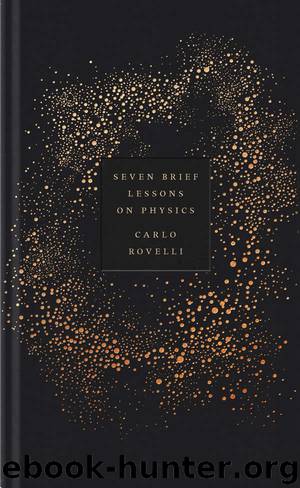Seven Brief Lessons on Physics by Carlo Rovelli

Author:Carlo Rovelli [Rovelli, Carlo]
Language: eng
Format: epub
Publisher: Penguin Books Ltd
Published: 0101-01-01T00:00:00+00:00
Is it possible to verify this theory experimentally? We are thinking, and trying, but there is as yet no experimental verification. There are, however, a number of different attempts.
One of these derives from the study of black holes. In the heavens we can now observe black holes formed by collapsed stars. Crushed by its own weight the matter of these stars has collapsed upon itself and disappeared from our view. But where has it gone? If the theory of loop quantum gravity is correct, matter cannot really have collapsed to an infinitesimal point, because infinitesimal points do not exist – only finite chunks of space. Collapsing under its own weight, matter must have become increasingly dense, up to the point where quantum mechanics must have exerted a contrary, counterbalancing pressure.
This hypothetical final stage in the life of a star, where the quantum fluctuations of space-time balance the weight of matter, is what is known as a ‘Planck star’. If the sun were to stop burning and to form a black hole it would measure about one and a half kilometres in diameter. Inside this black hole the sun’s matter would continue to collapse, eventually becoming such a Planck star. Its dimensions would then be similar to those of an atom. The entire matter of the sun condensed into the space of an atom: a Planck star should be constituted by this extreme state of matter.
A Planck star is not stable: once compressed to the maximum it rebounds and begins to expand again. This leads to an explosion of the black hole. This process, as seen by a hypothetical observer sitting in the black hole on the Planck star, would be a rebound occurring at great speed. But time does not pass at the same speed for her as for those outside the black hole, for the same reason that in the mountains time passes faster than at sea-level. Except that for her, because of the extreme conditions, the difference in the passage of time is enormous, and what for the observer on the star would seem an extremely rapid bounce would appear, seen from outside it, to take place over a very long time. This is why we observe black holes remaining the same for long periods of time: a black hole is a rebounding star seen in extreme slow motion.
It is possible that in the furnace of the first instants of the universe black holes were formed, and that some of these are now exploding. If that were true, we could perhaps observe the signals which they emit when exploding, in the form of high-energy cosmic rays coming from the sky, thereby allowing us to observe and measure a direct effect of a phenomenon governed by quantum gravity. It’s a bold idea – it might not work, for example, if in the primordial universe not enough black holes were formed to allow us to detect their explosions today. But the search for signals has begun. We shall see.
Another of
Download
This site does not store any files on its server. We only index and link to content provided by other sites. Please contact the content providers to delete copyright contents if any and email us, we'll remove relevant links or contents immediately.
| Aeronautics & Astronautics | Astronomy |
| Astrophysics & Space Science | Comets, Meteors & Asteroids |
| Cosmology | Mars |
| Solar System | Star-Gazing |
| Telescopes | UFOs |
Tools of Titans by Timothy Ferriss(7765)
Turbulence by E. J. Noyes(7679)
Astrophysics for People in a Hurry by Neil DeGrasse Tyson(4987)
Secrets of Antigravity Propulsion: Tesla, UFOs, and Classified Aerospace Technology by Ph.D. Paul A. Laviolette(4894)
Design of Trajectory Optimization Approach for Space Maneuver Vehicle Skip Entry Problems by Runqi Chai & Al Savvaris & Antonios Tsourdos & Senchun Chai(4829)
Room 212 by Kate Stewart(4718)
Pale Blue Dot by Carl Sagan(4592)
The David Icke Guide to the Global Conspiracy (and how to end it) by David Icke(4363)
A Journey Through Divination and Astronomy by Publishing Pottermore(4239)
Apollo 8 by Jeffrey Kluger(3496)
Goodbye Paradise(3426)
Losing the Nobel Prize by Brian Keating(3418)
COSMOS by Carl Sagan(3329)
The Five People You Meet in Heaven by Mitch Albom(3309)
Brief Answers to the Big Questions by Stephen Hawking(3228)
How to Read Water: Clues and Patterns from Puddles to the Sea (Natural Navigation) by Tristan Gooley(3218)
The Order of Time by Carlo Rovelli(3063)
How to Read Nature by Tristan Gooley(3062)
A Brief History of Time by Stephen Hawking(2806)
